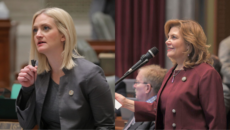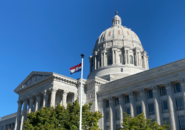JEFFERSON CITY, Mo. — State and federal investments are vital to ensuring more patients have access to telehealth services after the option’s popularity skyrocketed during the pandemic, according to Missouri providers.
Dr. Michelle Thomas, chief medical information officer for BJC Medical Group, said more than 190,000 patients used its telehealth services in 2020 amid the pandemic, up from just 4,000 participants in 2019.
Thomas said telehealth options have remained popular even after clinics opened back up to in-person appointments, allowing those dealing with anxiety or away from home to consult with their doctors remotely. Thomas said modernizing the state’s digital infrastructure would be a step toward allowing more Missourians to use the option.
“Telehealth is now a vital part of physicians’ toolkit in engaging patients and giving them the care that they need. It helps ensure patients receive the right care at the right place at the right time,” Thomas said. “There’s no single best policy for telemedicine, but the legislature and the state of Missouri can help ensure citizens have access to quality telehealth services.”
Thomas urged the House Special Interim Committee on Broadband Development to recommend more funding for telehealth services while it considers broadband expansion, a sentiment echoed by representatives from the Health Forward Foundation and MU Telehealth.
She also pointed to other states’ investments in digital literacy and urged lawmakers to alter regulations to expand insurance coverage to remote patients seeing providers licensed in other states — a barrier for numerous patients seeking virtual health services while traveling as well as those situated along the Illinois border. She said the change would widen the pool of available providers in future health emergencies like the pandemic.
Education
Telehealth wasn’t the only focus of Monday’s five-hour-long hearing: Department of Elementary and Secondary Education (DESE) Commissioner Margie Vandeven said the department had earmarked $50 million of its American Rescue Plan Act Elementary and Secondary School Emergency Relief (ESSER) fund to bridge the digital divide.
Missouri received $1.96 billion in total from the fund, with 90 percent headed to local districts and the remainder earmarked for statewide initiatives addressing the pandemic’s impacts.
Vandeven asked for the committee’s guidance as her department juggles an influx of funding and new technology opportunities.
“We’re getting bombarded with solutions and all sorts of different recommendations so we need experts to help us sort through that and get to the best solutions we can,” Vandeven said. “I’ve never seen our school leaders working as hard as they’re working today, and they’re bombarded with so many things that the better advice we can give, the more can be done.”
Higher Education Commissioner Zora Mulligan also addressed the impact of the digital divide on students, urging the legislature to consider more coordinated strategies between the state and education institutions to bridge the gap.
One community with a flourishing broadband network is Ralls County, according to Presiding Commissioner Wiley Hibbard. Hibbard told the committee his county was a year away from providing reliable broadband to all its residents through fiber.
Ralls County was able to quickly turn around its COVID relief money in cooperation with local electric cooperatives to expand its network over the past year, with a small portion of the area left to go, Hibbard said. He implored lawmakers to alter regulations to allow the use of “dark fiber,” unused infrastructure owned by utility companies, to expand coverage without regulatory barriers.
The legislature has plenty of funds on the way to bolster its broadband infrastructure: Missouri is expected to receive a minimum of $100 million to improve the state’s broadband infrastructure under the Infrastructure Investment and Jobs Act, providing access to more than 330,000 residents, as well as a $600,000 federal grant with a state match and other funds.
The committee’s report, due at the end of the year, will compile statistics, best practices, and policy recommendations. It will be presented to the General Assembly for consideration.
Missouri ranks No. 34 in broadband access, according to Broadband Development Director Tim Arbeiter, down two spots from where it sat in June as other states take steps to bridge the digital divide. There are more than 147,000 unserved or underserved households and more than 392,000 individuals without reliable internet access. The state has made drastic improvements despite the high numbers, increasing its ranking by 10 points since 2018.

Cameron Gerber studied journalism at Lincoln University. Prior to Lincoln, he earned an associate’s degree from State Fair Community College. Cameron is a native of Eldon, Missouri.
Contact Cameron at cameron@themissouritimes.com.









































